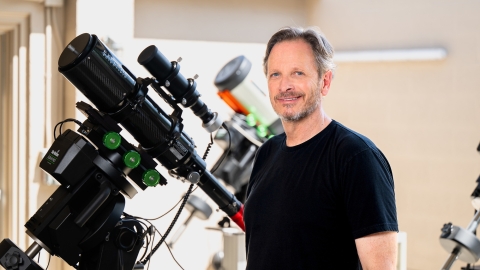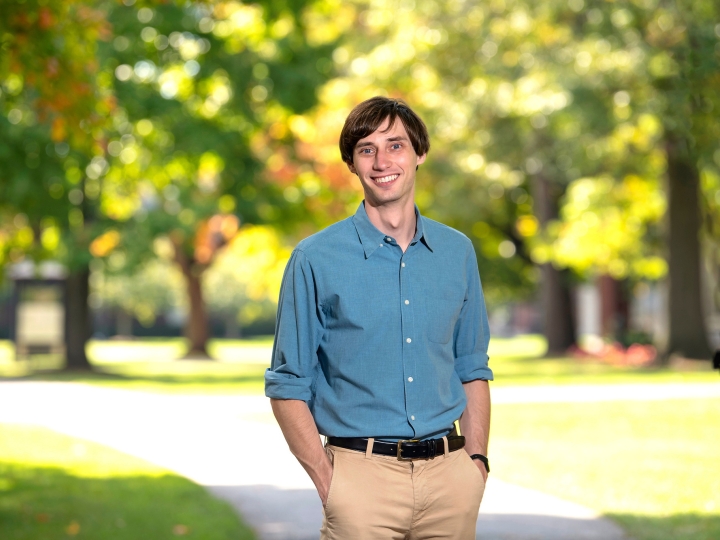
Jack Gallimore, Physics & Astronomy
August 20, 2025
Jack Gallimore, physics and astronomy, turns his attention to distant galaxies to reveal universal truths. Photo by James T. Giffen, Marketing & Communications
"I've been able to look at what students struggle with and then ask myself, 'What's something that might be more familiar that will allow them to understand the more complicated or esoteric details of astronomy?' "
No one has ever seen the inside of a black hole. Inside the event horizon, the proverbial point of no return, nothing — not even light — can escape its immense gravity. What is essentially unknowable about them has long served as fuel for the science fiction writer's imagination, wherein black holes facilitate everything from time travel, teleportation and the destruction of entire planets and galaxies. However, just because we haven't peered directly behind the curtain of the event horizon doesn't mean that black holes are complete mysteries.
"Every galaxy, at its center, has what's called a supermassive black hole. These are black holes that are typically exceeding a million times the mass of the sun, and most of them are dormant," says Professor Jack Gallimore, physics and astronomy. "But in something like 5 to 10% of these galaxies, black holes are actively feeding. We call them active galaxies."
Gallimore's research into black holes began as a doctoral student at the University of Maryland. After graduation, he held postdoctoral and fellowship positions at research institutions and observatories around the world, including Germany's Max Planck Institute for Extraterrestrial Physics and the National Radio Astronomy Observatory in Charlottesville, Virginia, before joining Bucknell in 2000.
With decades of experience under his belt, Gallimore's research has covered a lot of astronomical ground. "There are essentially two different ways of doing observational astronomy," he says. "One is, you can look at many different galaxies to get a big statistical picture. With the other, you can look at just a few in greater detail. You end up learning a lot by taking both of these approaches."
In his time at Bucknell, Gallimore has made discoveries and published papers based on both of these approaches, including a 2006 paper that still informs projects being conducted by teams of researchers at both the Rochester Institute of Technology and Inter-University Centre for Astronomy and Astrophysics in Pune, India. "It's become kind of an important paper, — it's about large-scale radio outflows from active galaxies," he says. "The group in Pune has really taken off with that project. I'm helping supervise graduate students there as they work through new observations and data sets."
More recently, Gallimore's focus has shifted to one particular galaxy about 45–50 million lightyears away. Somewhat of a celebrity in the astronomy world, NGC 1068, also known as the M 77, has been widely studied, but the supermassive black hole at its center has remained relatively shrouded in mystery, or rather, clouds of dust and gas. Gallimore and his team, including Bucknell physics student Virginia Hostetter '25, set out to complete an astrometric mapping of the galaxy's radio continuum in unprecedented detail and take polarization measurements of its water masers, which refers to water vapor that amplifies microwave radiation.
Using a network of ten radio telescopes and an exceedingly challenging technique called VLBI spectropolarimetry, Gallimore, his colleagues, and students discovered magnetic filaments around the galaxy's supermassive black hole. "We've observed that the black hole paradoxically launches a powerful wind that impacts the surrounding galaxy, but the mechanism was unknown. Our discovery points to magnetic fields rotating with the accretion disk surrounding the black hole. The magnetic fields sweep up gas and launch them to thousands of light years away like a cosmic version of the hammer throw. It's a theory that was proposed decades ago," he says. "This is the first time it's been observed in detail, where we can see evidence that this theory has some merit."
In many ways, Gallimore's research is oriented around revealing the underlying architecture of the universe. "The idea is that, to some extent, galaxies and their central black holes are coeval. They formed together from the same processes. By looking at the evolution over time, we might be able to get to the picture of the major process that started with a random assortment of black hole masses and galaxy masses and then led to a correlated set," he says. "I think that connection hasn't been made yet. This is one of the reasons I'm so interested in outflows. If we understand nearby outflows, we might be able to apply that knowledge to the more distant galaxies and try to complete that picture."
Bucknell's College of Arts & Sciences has proved an ideal laboratory for allowing Gallimore to pursue his research and to train and mentor the next generation of astronomers and physicists. Uncovering — literal — universal truths is a heady project, though his decades of experience have honed his ability to translate complex concepts into opportunities for learning. "I've been able to look at what students struggle with and then ask myself, 'What's something that might be more familiar that will allow them to understand the more complicated or esoteric details of astronomy?' " he asks.
To find answers, he and his students look beyond the classroom and into the distant reaches of the universe.

